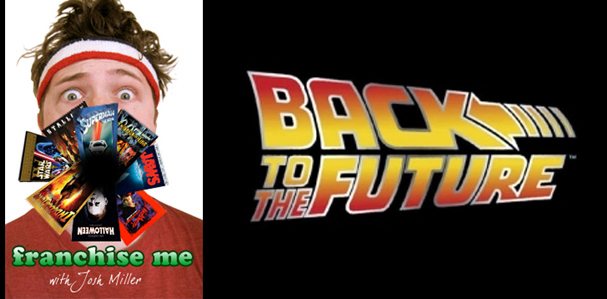
Hollywood loves a good franchise. The movie-going public does too. Horror, action, comedy, sci-fi, western, no genre is safe. And any film, no matter how seemingly stand-alone, conclusive, or inappropriate to sequel, could generate an expansive franchise. They are legion. We are surrounded. But a champion has risen from the rabble to defend us. Me. I have donned my sweats and taken up cinema’s gauntlet. Don’t try this at home. I am a professional.
Let’s be buddies on the Facebookz!
Buy my newest book!
The Franchise: Back to the Future: following the time-traveling adventures of teenager Marty McFly, eccentric inventor Dr. Emmett “Doc” Brown, and Brown’s creation, a 1981 DeLorean DMC-12 that has been modified into a time-machine. From 1985 to 1992, the franchise spanned three films and an animated television series.
previous installments
Back to the Future
Back to the Future II
Back to the Future III
Back to the Future (TV Series)
The Installment: Back to the Future: The Game (2010, 2011)
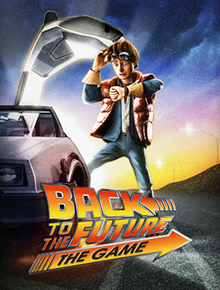
The Story:
We join Marty and Doc in the familiar Twin Pines mall parking lot scene from the first film. Only this time, instead of terrorists showing up for the least inconspicuous assassination ever, Doc Brown creepily winks out of existence. But it turns out this is all a dream. Sort of. Marty wakes up, at home, in 1986. The last time he saw Doc, Doc was flying away in a time-traveling train with his wife and two creepy sons. Unable to tell anyone the truth, obviously, Marty had to let the rest of Hill Valley assume that Doc has disappeared. Then one day, the DeLorean mysteriously arrives back in town; empty. After some sleuthing Marty discovers that Doc became trapped in 1931, blamed for burning down a speakeasy belong to (of course) an ancestor of Biff. So Marty travels back to the Prohibition era and gets tangled up with mobsters, a young Emmett Brown, and Edna Strickland, the equally authoritarian sister of slacker-hating Principal Strickland. A clusterfuck of multiple timelines, unexpected romances, and various ancestors ensues.
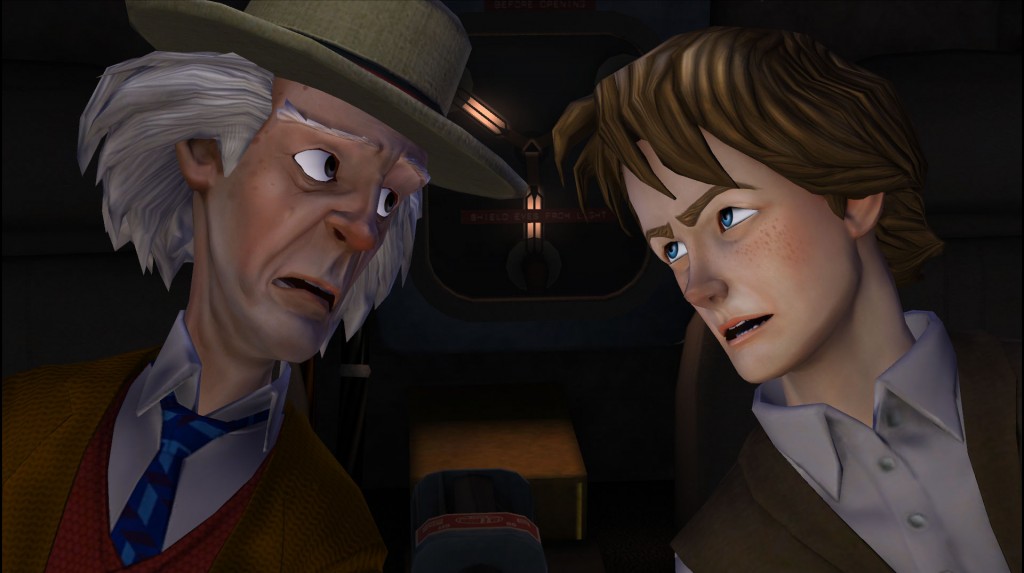
What Works:
I should note right off the bat here that I didn’t actually play the Back to the Future: The Game. I watched youtube videos of someone else playing it (thanks Internet nerds!). Normally I’d call bullshit on something like that, but I don’t include video games in Franchise Me for the simple reason that video games and films/TV are such completely different things. Video games are certainly capable of offering equal, sometimes even more visceral entertainment to films/TV when it comes to creeping you out (BioShock) or making you laugh (Portal), but I’ve never heard someone say a game with shitty game-play was good because of the dialogue or awesome camerawork in a cutscene. For example, I loved the first Buffy The Vampire Slayer Xbox game. The cutscenes were lame and the “story” was irrelevant. I just liked playing it. But point-and-click adventure games are a little different. Back in the day I was a huge fan of the LucasArts adventure games, particularly the work of Tim Schafer (Grim Fandango blew my mind). While obviously the ‘game’ aspect of these video games was a crucial component to my entertainment, the low-impact interaction nonetheless put more emphasis on the writing and “performances.” I wanted to solve the puzzles so I could get to the point where I could stop playing and get further into the story. Whether or not BTTF: The Game is fun to play has nothing to do with why I chose to include it here. I included it because the makers of the game took their storytelling very seriously. This isn’t just a video game featuring the characters from the movies. BTTF: The Game is the closest we’ll ever get to a BTTF IV, and it actually makes for a semi-acceptable substitute. Point being, watching a recording of the game unfolding on youtube seemed like the best way to judge its worth for the context of this column.
So a big commendation must go to designers/writers Michael Stemmle and Andy Hartzell, who seem to be the primary creative force behind the project. The restrictions of the point-and-click format and just the reality of being a game in general obviously handicap things, when compared with the films. But Stemmle and Hartzell are able to really capture the spirit and tone of the trilogy. In a way the game is frankly somewhat superior to the two sequels. Let me explain that. The game is actually five different games, released separately, that tell one long serialized story — what adds up to a several-hours-long movie if you string all the cutscenes and dialogue interactions together. As we’ve already talked about, the choice to make II and III one long story, yet polar opposites structurally and tonally, left each respective films weak in certain yin and yang areas. II had all the pizzazz, but no heart. III had all the heart, but no pizzazz. The Game‘s story makes II seem like My Dinner With Andre – we get not one, not two, but three alternate timeline screw-ups, three different Doc Browns, two DeLoreans, and a host of twists and turns – yet, we have the luxury of needing to fill up a lot of time. This allows the game to have a crazy, zigzagging story while still focusing intimately on the characters.
As for those characters. Part of the problem with BTTF the TV series was that it had Doc and Marty in basic archetype only. Without Lloyd or Fox, they felt like different characters. And in the case of Marty, a way, way less interesting character. Here we’ve got Lloyd providing his own voice. Unfortunately the ravages of disease likely made it impossible for Fox to return (he does show up though in the lesser role of Marty’s great-grandpa William; who peed on Marty in III). But A.J Locascio does such an eerily dead-on impression of Fox’s Marty that you honestly can’t tell the difference. This allows Doc and Marty to function like they’re supposed to. More importantly, it allows Marty to reclaim the franchise as his own, with a new wrinkle too. The sequels are good films, but the Bobs weren’t able to recapture the magic of the first film, in part I think because they switched up how Marty behaved in relation to Doc and other characters. In the first film Marty was on his own, so he was the instigator. He needed to talk Young Doc into helping him. In II, Doc is the instigator, telling Marty where to go and what to do. III was briefly able to recapture the 1955 magic, but once Marty got to 1885, he became a third wheel waiting around for Doc to advance the story. Now Marty is front and center the whole time. Old Doc is in jail in 1931, so he is limited in his abilities, and once again Marty needs the assistance of the Emmett Brown already living in that time period; a twenty-something Emmett Brown (who I’ll just call Emmett to avoid confusion). The wrinkle this time is that Emmett has yet to decide to become a scientist, so Marty can’t tell him the truth. This puts Emmett in the same role as George McFly from the first film. And it works great. Stemmle and Hartzell make good use of the fragments of Doc’s past to construct 1931’s Emmett Brown. We knew from III that Doc’s father was an immigrant who changed the family’s name from Von Braun to Brown during WWI. Here Doc’s father, a German-accented overbearing jerk, wants Doc to become a lawyer. In BTTF we encountered Doc at the point when he’d first conceived time-travel. Now we’re encountering him at the crucial crossroads where he decides to journey down the road of science in the first place. And this becomes the launching point for the story’s most interesting complications…
The most inspired and inventive portion of the game’s story is in Game #3, “Citizen Brown,” in which Marty arrives back in 1986 to find a Hill Valley living under the dictatorial control of Doc Brown. This Brown has short hair and has used his genius to mold Hill Valley into the “perfect” city, free from sinful ways and imperfections. It turns out that because of things Marty did in 1931, Emmett ended up marrying Edna Strickland, who reshaped Emmett’s life-goals for the worse. When Marty proves to the unhappy First Citizen Brown that he’s living the wrong destiny, things get particularly fun and ultimately dramatic when Citizen Brown helps Marty fix the DeLorean and both go back to 1931. At first Citizen Brown is eager to help Marty correct the timeline, but when Citizen Brown encounters 1931’s Edna (before she turned into a completely evil bitch), his love for what she used to be causes him to turn against Marty. This reversal makes you realize that focusing II around Biff was a mistake. Biff works better as a side character. Having an alternate Doc become a villain is just so perfect for the franchise. And the scene in which Marty finally succeeds, and Citizen Brown dies (ie, winks slowly out of existence) would have been amazing in a live-action film. It is still great here. The moment that works just as well even in game form is the scene in which Marty thinks he has failed to rekindle Emmett’s dedication to science, after Emmett’s invention destroys the Hill Valley Science Fair, but over the course of a paragraph of Emmett’s rambling dialogue you realize Emmett has in fact embraced his true love — the moment hits home emotionally. The game is also able to add a new wrinkle to the alternative timeline gimmick. We again get an alternate present (two actually). But after young Edna uses the DeLorean as a getaway car in 1931, the entire city of Hill Valley suddenly disappears around Doc and Marty. It made me realize that a complication like that probably should have happened in III to keep things spicy.
The game also features a substantially more gratifying ending than III did. The ending to the film trilogy was a happy one — for Doc. But Marty was left screwed without a time machine while Doc got to gallivant around time like a big fat hypocrite. The game concludes in a wonderful it of BTTF franchise goofing, in which another Marty (this one I believe voiced by Fox) suddenly shows up in a DeLorean saying he needs Doc’s help. Then another DeLorean shows up, and out hops yet another Marty. Then yet another DeLorean and yet another Marty. But Doc and Marty chose to ignore all three and hop in their own DeLorean. Marty asks Doc where they should go, and for once Doc doesn’t have the answers, replying, “Surprise me.” Come on. That’s fabulous. It kind of white washes Clara and the two sons, who are mentioned often in the game but never seen, but whatever. I never gave a crap about them.
This doesn’t affect the quality of the game at all, but it is interesting to note that Claudia Wells reprises her role as Jennifer in the game.
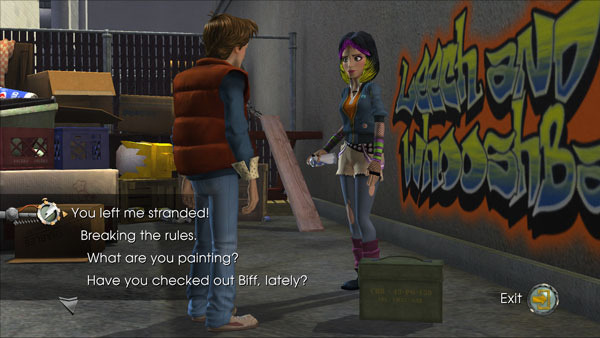
What Doesn’t Work:
Well, it is a video game. The writing is good and the gags are funny, but it is still low-impact storytelling because very few plot points come flying at you. The ideas are all there but there is just no way it can compare to a well-done motion picture. I really loved the game’s story, but I can’t imagine ever revisiting it.
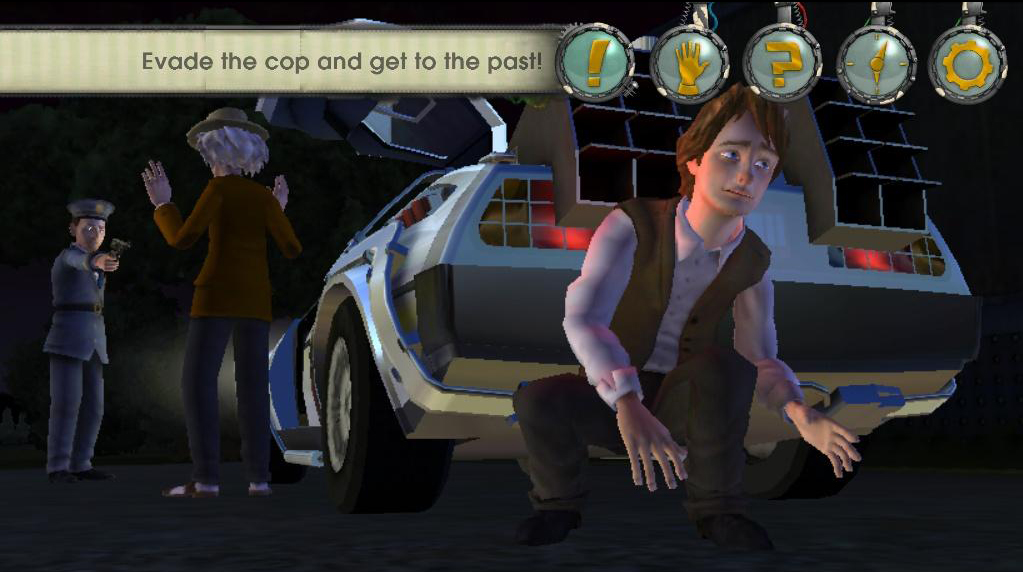
Best Biffism: Oddly, in all the dialogue we get from Biff and his ancestor Kid Tannen, I didn’t catch any Biffisms.
Best Contribution to History: None of these either.
Marty’s Best Use of Future Superiority: When he is able to befriend Emmett by solving an equation that Emmett is devising (using Doc’s help from jail, of course).
Time Travel Murkiness: The game plays fast and loose with the idea of time “catching up” to alternate timelines. There certainly isn’t a fixed time-frame here.
Most Rosy View of the Past: Well, we don’t see anyone getting drunk off of bootlegger alcohol. Though I don’t know if that counts as being rosy.
How the Characters Could Have Better Used Time Travel: They use it pretty well actually.
Should There Be a Sequel: Totally. More games.
Franchise Assessment:
Back to the Future is both a great and kind of blah franchise, depending on how you look at it. The film trilogy is definitely great, though also buoyed mostly by the strength of the first film and the momentum of our feelings for Lloyd and Fox. I don’t think it could have withstood a fourth film continuing down the same path, and that means something. Part of the problem was the decision to have the three films tell a very narrow story. I don’t feel like doing the actual math, but all the three films transpire continuously over the course of about a week total. This added some urgency to the individual stories, but having each film pick up immediately where the other left off also prevented our characters from being able to evolve much — which is presumably why the Bobs retconned Marty’s “chicken” thing into the sequels (it wasn’t like they could imply anything happened between BTTF and BTTF II because there was no “between,” and it comes off like the Bobs are guessing at the personality of their own character). It is a pros and cons situation, because conceptually it is cute that this epic adventure all happened so quickly. It just lessens some of the possibilities considerably. And I can’t help but be curious what a Back to the Future III might have looked like if Back to the Future II had been a stand-alone film. We most likely would have gotten at least a BTTF IV before Michael J Fox’s Parkinson’s disease pushed him into semi-retirement.
I also can’t help but wonder what this franchise would have looked like if the Bobs had settled into a different headspace for the sequels. II firmly establishes that the shtick of the series is callbacks, seeing familiar franchise touchstones – be they characters, actors, locations, or situations – filtered through whatever time period we happen to be in. You could call this an “Ewok Decision.” Because, as a kid, those callbacks were precisely what I loved about the sequels, especially II. But the decision was also alienating to anyone who responded to the emotional elements of the first film; elements that arguably are what made the film so excellent. But I think this also steers the conversation to the conundrum of the whole franchise, which we’ve been discussing since the first installment — this is a time-travel franchise based on a film that wasn’t really about time-travel…
BTTF didn’t need a time-machine. The DeLorean time-machine was a byproduct of the time period. For one thing, the 1980s saw the rise of gizmos. It seemed like every nerd in film and television had the ability to build a robot. Weird tech was exciting and novel. Further more, the 80s were very materialistic. Marty’s dream is to have that sweet truck and his happy ending is partially based around actually getting the truck. Having a time-traveling car was simply a “cool” idea to get Marty to the past. But think about this: the movie could have played out almost exactly the same without a time-machine at all. BTTF is a nostalgia movie about a kid understanding his parents. It has a lot more in common with Peggy Sue Got Married than it does Bill & Ted’s Excellent Adventure. Marty could have wound up in 1955 through a freak accident in which he is struck by lightning, maybe helping Doc with a weather experiment, and he needs Doc to replicate the same experiment in 1955 so he can get struck by the lighting that hits the clock tower. The movie would not be nearly as iconic, and probably not as interesting without the DeLorean, but the fact remains that the plot wouldn’t need to change. But people loved the DeLorean. It represented so many possibilities and inspired our fantasies. And it seems like on some small level the Bobs were annoyed that they needed to explore those possibilities. II feels like, “Fine, here you go 12yearolds. Let’s get crazy.” Yet, in the film they still latch onto some great time-travel concepts. There were more places to go. For example, at no point did they ever use the time machine to keep trying and failing to fix something, traveling back in time again and again and again, Groundhog Day-style, until they get something specific right. Considering they intentionally closed down the franchise after three films, a lot of doors were left unopened and unexplored. And The Game really demonstrates this. Just a simple shot of the DeLorean appearing in 1931, in between a cop car and a gangster car shooting guns at each other, makes you realize the endless possibilities for cinematic fun we never got to see.
Franchise ranked from best to worst:
Back to the Future
Back to the Future II | Back to the Future III
Back to the Future: The Game
Back to the Future (TV Series)
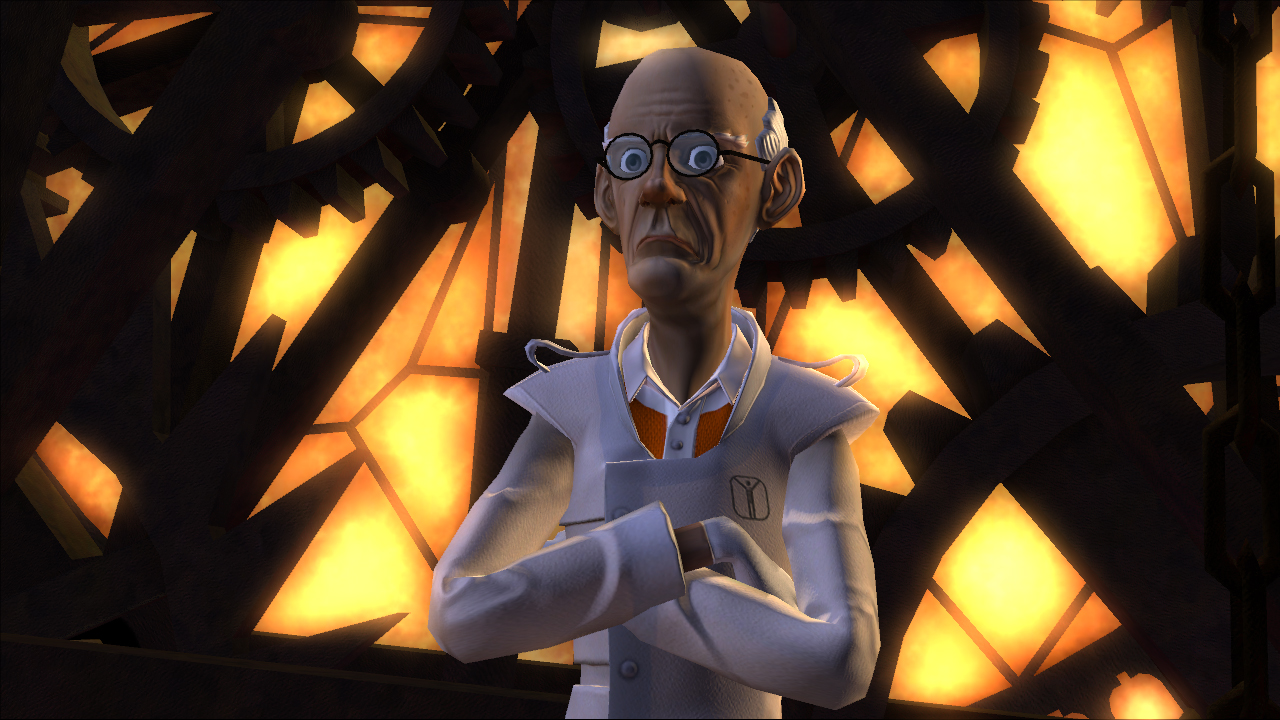
Up Next: Die Hard
previous franchises battled
Alien
Critters
Death Wish
Hellraiser
Home Alone
Jurassic Park
Lethal Weapon
Leprechaun
Meatballs
The Muppets
Phantasm
Planet of the Apes
Police Academy
Predator
Psycho
Rambo
Tremors